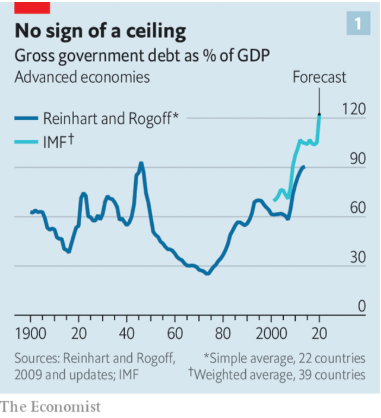Inflation-adjusted interest rates in the US have been negative before, but the dip below zero this time is different vs. recent decades: the slide is accompanied by a global economic collapse that may or may not be temporary.
It’s unclear if the latest return of negative real yields will descend further, but in the current climate the downward bias isn’t easily dismissed. Perhaps the current episode will be a brief affair. That would likely require a relatively quick rebound in economic growth to something approximating normal. But with so much uncertainty weighing on the outlook, courtesy of the unknown path of the coronavirus crisis, no one is sure if the US and the world is facing a new world order of incessantly negative real yields.
What’s striking about past bouts of negative real yields is that the episodes tended to be driven by spikes in inflation. In the 1970s, for example, the real 10-year Treasury yield (deflated by the annual change in the Consumer Price Index) fell to nearly -5% on two separate occasions.

The current return to negative real yields is a different animal because it’s been unleashed (so far) by a sharp drop in interest rates while inflation has remained modest but relatively steady. The annual pace in headline consumer prices rose 1.5% in March vs. the year-earlier level (in unadjusted terms). Meanwhile, the 10-year Treasury yield is currently below 1%, settling at 0.72% yesterday (May 6).
The are several implications in a world of negative real yields. For investors, the situation forces a decision with respect to bonds: the only way to achieve a real positive return is to embrace more risk. This spills over into asset allocation strategy. If conventional bond holdings will stumble in terms of delivering acceptable returns after adjusting for inflation, a greater allocation to risk assets (stocks, for example) may be required. Alternatively, holding the asset mix steady while shifting the bond holdings into higher yielding securities is an option (more junk bonds, for instance).
Perhaps the biggest risk is that negative real rates point to a rising threat of deflation. That’s not so easy to shrug off amid a deep recession. This much is clear: the world is awash in debt, and the burden of servicing that debt will grow sharply amid deflation.
As The Economist notes:
“advanced economies will run an average deficit this year of 11% of GDP, according to the IMF, even if the second half of the year sees no more lockdowns and a gradual recovery. Rich-world public debt could run to $66 trillion, which might be 122% of GDP by year’s end.”

Deflation and surging debt are a toxic mix. The question is whether a new deflationary period is fate? Some analysts have their doubts. But until the global economy recovers, the potential for deflation will linger.
In fact, recent research suggests that a centuries-long trend points to a disinflation/deflation bias generally. A Bank of England study advises: “Currently depressed sovereign real rates are in fact converging ‘back to historical trend’ — a trend that makes narratives about a ‘secular stagnation’ environment entirely misleading, and suggests that — irrespective of particular monetary and fiscal responses — real rates could soon enter permanently negative territory.”
The Federal Reserve and other central banks are desperately trying to steer economies out of a deflation trap. The prospects for success, however, remain open for debate.
Kenneth Rogoff, a former chief economist at the IMF and currently an economics professor at Harvard, argues that central banks, including the Fed, should consider “deeply negative interest rates.” It’s a highly controversial idea, but Rogoff argues that it may be the only practical path left in a world that’s saddled with rapidly rising debt levels and low odds for a rapid economic recovery.
“Emergency implementation of deeply negative interest rates would not solve all of today’s problems,” he admits. “But adopting such a policy would be a start. If, as seems increasingly likely, equilibrium real interest rates are set to be lower than ever over the next few years, it is time for central banks and governments to give the idea a long, hard, and urgent look.”
